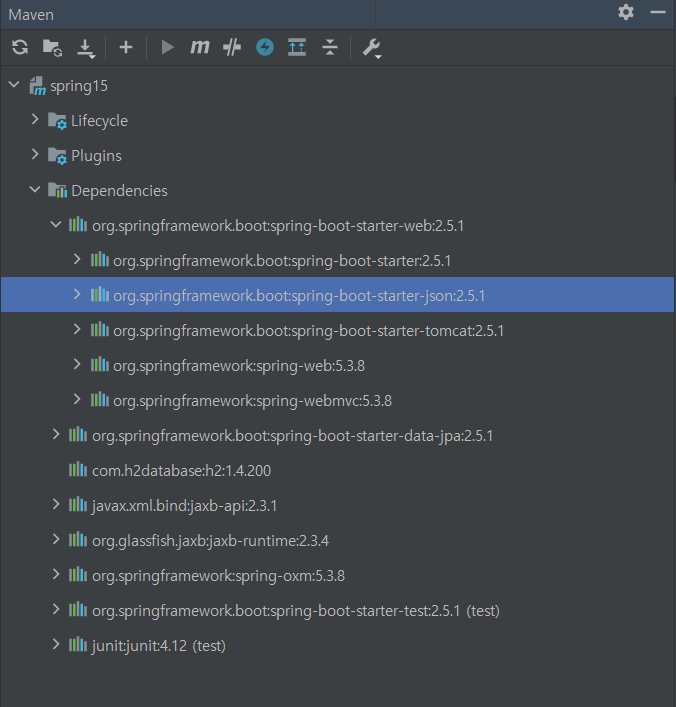12. HTTP 메시지 컨버터
HTTP 메시지 컨버터
- 요청 본문에서 메시지를 읽어들이거나(@RequestBody), 응답 본문에 메시지를 작성할 때(@ResponseBody) 사용한다.
@RestController
public class SampleController {
@GetMapping("/message")
public @ResponseBody String message(@RequestBody String body){
return body;
}
}테스트 작성
@RunWith(SpringRunner.class)
@SpringBootTest
@AutoConfigureMockMvc
public class SampleControllerTest {
@Autowired
MockMvc mockMvc;
@Test
public void stringmessage() throws Exception{
this.mockMvc.perform(get("/message")
.content("hello"))
.andDo(print())
.andExpect(status().isOk())
.andExpect(content().string("hello"));
}
}기본 HTTP 메시지 컨버터
- 바이트 배열 컨버터
- 문자열 컨버터
- Resource 컨버터
- Form 컨버터 (폼 데이터 to/from MultiValueMap<String, String>)
여기서부터는 classpath에 있는 경우만 등록된다.
- (JAXB2 컨버터)
- (Jackson2 컨버터)
- (Jackson 컨버터)
- (Gson 컨버터)
- (Atom 컨버터)
- (RSS 컨버터)
- ...
어떤 메시지 컨버터를 쓸지는 요청 헤더에 Content-Type, accpet을 보고 결정한다.
또 WebMvcConfigure에 configureConverters라는 메소드를 통해 메시지 컨버터를 추가할 수도 있지만 이를 사용해 메시지 컨버터를 추가하면 기본 컨버터는 사용할 수 없다. 따라서 추가만 하고 싶은 경우는 extendMessageConverts라는 메소드를 사용하면 된다.
설정 방법
- 기본으로 등록해주는 컨버터에 새로운 컨버터 추가하기: extendMessageConverters
- 기본으로 등록해주는 컨버터는 다 무시하고 새로 컨버터 설정하기 : configureMessageConverters
- 의존성 추가로 컨버터 등록하기 (추천)
- 메이븐 또는 그래들 설정에 의존성을 추가하면 그에 따른 컨버터가 자동으로 등록 된다.- WebMvcConfigurationSupport
- (이 기능 자체는 스프링 프레임워크의 기능임, 스프링 부트 아님.)
- WebMvcConfigurationSupport
13. HTTP 메시지 컨버터 JSON
스프링 부트를 사용하지 않는 경우(WebMvcConfigurationSupport)
- 사용하고 싶은 JSON 라이브러리를 의존성으로 추가
- GSON
- JacksonJSON
- JacksonJSON 2
스프링 부트를 사용하는 경우
- 기본적으로 JacksonJSON 2가 의존성에 들어있다.
- 즉, JSON용 HTTP 메시지 컨버터가 기본으로 등록되어 있다.

도메인 클래스
@Entity
public class Person {
@Id @GeneratedValue
private Long id;
private String name;
public Long getId() {
return id;
}
public void setId(Long id) {
this.id = id;
}
public String getName() {
return name;
}
public void setName(String name) {
this.name = name;
}
}컨트롤러 클래스
@RestController
public class SampleController {
@GetMapping("/jsonMessage")
public Person jsonMessage(@RequestBody Person person){
return person;
}
}테스트 코드
@RunWith(SpringRunner.class)
@SpringBootTest
@AutoConfigureMockMvc
public class SampleControllerTest {
@Autowired
MockMvc mockMvc;
@Autowired
PersonRepository personRepository;
@Autowired
ObjectMapper objectMapper;
@Test
public void jsonMessage() throws Exception {
Person person = new Person();
person.setId(2019l);
person.setName("spring");
String jsonString = objectMapper.writeValueAsString(person);
this.mockMvc.perform(get("/jsonMessage")
.contentType(MediaType.APPLICATION_JSON_UTF8)
.content(jsonString)
.accept(MediaType.APPLICATION_JSON_UTF8))
.andDo(print())
.andExpect(status().isOk())
.andExpect(jsonPath("$.id").value(2019))
.andExpect(jsonPath("$.name").value("spring"));
}
}json 응답의 본문을 확인할 때는 JSON path를 사용할 수 있다.
또는 postman이라는 클라이언트를 통해 서버를 띄워서 테스트할 수도 있다.
14. HTTP 메시지 컨버터 XML
OXM(Object-XML Mapper) 라이브러리 중에 스프링이 지원하는 의존성 추가
- JacksonXML
- JAXB
스프링 부트를 사용하는 경우
- 기본으로 XML 의존성 추가해주지 않음.
- WebMvcConfigurer에 Bean으로 Jaxb2Marshaller 메시지 컨버터 등록
- pom.xml에 JAXB 의존성 추가
<dependency>
<groupId>javax.xml.bind</groupId>
<artifactId>jaxb-api</artifactId>
</dependency>
<dependency>
<groupId>org.glassfish.jaxb</groupId>
<artifactId>jaxb-runtime</artifactId>
</dependency>
<dependency>
<groupId>org.springframework</groupId>
<artifactId>spring-oxm</artifactId>
<version>${spring-framework.version}</version>
</dependency>- WebMvcConfigurer에 Bean으로 Jaxb2Marshaller 메시지 컨버터 등록
@Configuration
public class WebConfig implements WebMvcConfigurer {
@Bean
public Jaxb2Marshaller jaxb2Marshaller(){
Jaxb2Marshaller jaxb2Marshaller = new Jaxb2Marshaller();
jaxb2Marshaller.setPackagesToScan(Person.class.getPackageName());
// Person.class가 있는 패키지 이름을 scan해서
// @XmlRootElement 애노테이션이 있는지 확인
return jaxb2Marshaller;
}
}- 도메인 클래스에 @XmlRootElement 애노테이션 추가
@XmlRootElement
@Entity
public class Person {
@Id @GeneratedValue
private Long id;
private String name;
public Long getId() {
return id;
}
public void setId(Long id) {
this.id = id;
}
public String getName() {
return name;
}
public void setName(String name) {
this.name = name;
}
}- 테스트 코드
@RunWith(SpringRunner.class)
@SpringBootTest
@AutoConfigureMockMvc
public class SampleControllerTest {
@Autowired
MockMvc mockMvc;
@Autowired
PersonRepository personRepository;
@Autowired
Marshaller marshaller;
@Test
public void xmlMessage() throws Exception {
Person person = new Person();
person.setId(2019l);
person.setName("spring");
StringWriter stringWriter = new StringWriter();
Result result = new StreamResult(stringWriter);
marshaller.marshal(person, result);
String xmlString = stringWriter.toString();
this.mockMvc.perform(get("/jsonMessage")
.contentType(MediaType.APPLICATION_XML)
.content(xmlString)
.accept(MediaType.APPLICATION_XML))
.andDo(print())
.andExpect(status().isOk())
.andExpect(xpath("person/name").string("seonju"))
.andExpect(xpath("person/id").string("2019"));
}
}xml 응답의 본문을 확인할 때는 Xpath를 사용할 수 있다.
역시 postman이라는 클라이언트를 통해 서버를 띄워서 테스트할 수도 있다.
참고
- 인프런 : 스프링 웹 MVC(백기선)
- https://docs.spring.io/spring-framework/docs/current/javadoc-api/org/springframework/web/servlet/config/annotation/WebMvcConfigurer.html#configureMessageConverters-java.util.List
- https://docs.spring.io/spring-framework/docs/current/javadoc-api/org/springframework/web/servlet/config/annotation/WebMvcConfigurer.html#extendMessageConverters-java.util.List
- https://www.baeldung.com/spring-httpmessageconverter-rest
- https://github.com/json-path/JsonPath
- http://jsonpath.com/
- https://www.w3schools.com/xml/xpath_syntax.asp
- https://www.freeformatter.com/xpath-tester.html
